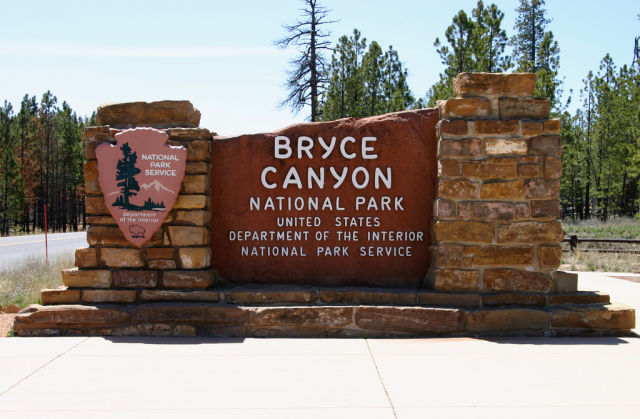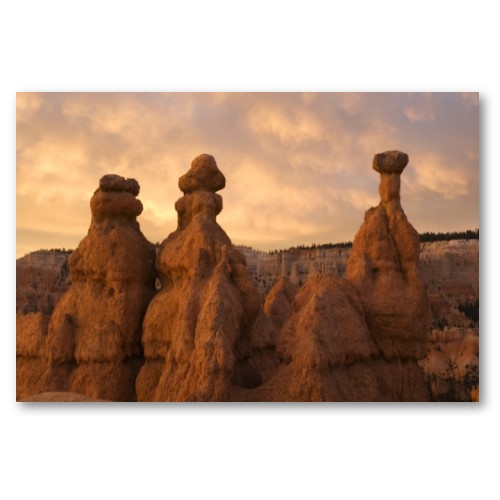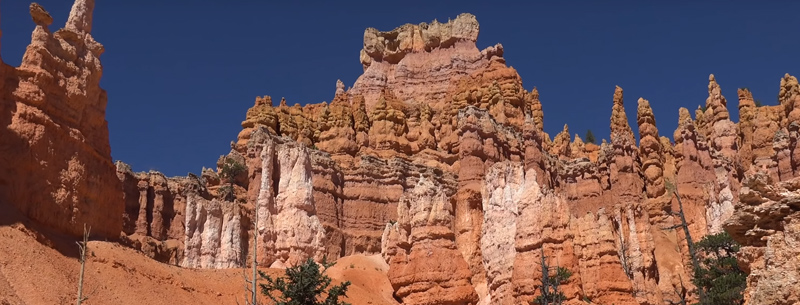This park is most famous for its hoodoos, which are pillars of rock formed by weathering and water erosion; the best examples in the world are found in Bryce Canyon. The park has plenty of activities to entertain guests, from ranger lead moonlight hikes to camping under the stars and horseback rides amongst the rocks. The park is home to a large range of wildlife including the mountain lion and bobcat and there are also many bird species from the endangered Californian Condor to the migrating swallows and swifts. Bryce Canyon maybe more remote than other Utah parks but is well worth a visit.
Dark Reds, vibrant oranges, warm earth-toned browns, and whites combine like an artist’s palette at southwestern Utah’s Bryce Canyon National Park. The amphitheater area contains large geological rock formations called hoodoos. A unique combination of wind erosion, water and ice have sculpted the rock into thousands of gigantic spikes in the area known as Bryce Canyon.

Bryce Canyon provides one of the greatest views of any National Park in the country. The high elevation also affords an unusually long distance view for the “Grand Circle” area of the southwest. The area even experiences light snowfall during the winter months, while heating up to the ’90s and above during the peak summer. These framed prints are excellent photographic examples of why this park is a must-see for any National Parks enthusiast and would look perfect on any wall in your home or office.
Under the Rim Trail
The Under the Rim Trail is the longest in the park, and also the most strenuous hiking trail. At 23 miles long, you will need to set camp during this long trek over the park. The trail will afford views of Yellow Creek, the Natural Bridge, and Bryce Point.
Easy Hikes in Bryce Canyon
Bryce Canyon has a good range of easy to strenuous hikes throughout the park. With all hikes, you should be prepared with plenty of water and the right hiking boots, as well as the proper permits.
Right Fork Yellow Creek is a short hike of only 3 miles, offering beautiful views of Ponderosa Pines and hoodoos, passing unique cacti and wildflowers in the warmer months. Right Fork Swamp Canyon also affords beautiful views and a mere 1.1-mile walk from the Sheep Creek Swamp Canyon parking lot.
If you’re looking for some very easy hikes, around the amphitheater area of Bryce Canyon you can find hikes that are 1/2 mile or less, like from Inspiration Point to Bryce Point along the Rim Trail.
A Guide to Zion and Bryce Canyon National Parks
These two parks are often visited on the same trip!
Wild, vast and rugged, Zion and Bryce Canyon are among America’s most dramatic national parks, filled with towering cliffs, hanging gardens, and a riot of surreal, rainbow-striped rock formations. Whether you want to hike narrow slot canyons or admire stunning views, this indispensable guide will help you explore these desert jewels, plus the best of southern Utah’s other parklands.
Using Caution Within Bryce Canyon
Hiking around Bryce Canyon — where to go and what to avoid
The National Park Service reminds us:
Keep in mind that all trails below the rim involve steep climbs out of the canyon. Here are a few more hiking reminders;
- Wear hiking boots with good “lug” traction and ankle support.
- Carry plenty of water; 1 quart (liter) per 2-3 hours of hiking for each person
- Park elevations reach over 9,000 feet (2774 meters). Even mild exertion may leave you feeling light-headed and nauseated.
- Some trails are also shared by horses/mules from April to October. Hikers must yield to horses/mules. Hiking clockwise reduces your chances of encountering horses/mules.
- Stay on maintained trails. DO NOT use “social” trails.
- Be respectful of others; keep noise levels down – no yelling.
- Do not feed wildlife.
- Remember, ultimately, you are responsible for your own safety.
It Gets Hot!
Bryce Canyon and all of Southern Utah can get very hot in the summer months. The most comfortable times to hike the park are in the late spring and early fall months. However, since Bryce is at a higher elevation, it can be cooler than other areas of Southern Utah.
How Was Bryce Canyon Formed?
The scientific history of Bryce simplified.
Bryce Canyon is a misnomer of sorts. It isn’t technically a canyon. Canyons are carved from a river over millions of years through erosion. Bryce was created from headward erosion, which basically leaves a series of steep rock formations in its path. Bryce Canyon is an extreme example of this! These large pinnacles are called hoodoos. The hoodoos of Bryce Amphitheater extend 20 miles within the National Park.

When trying to figure out how these formations were formed, think of what isn’t there and instead of what is there. Think of the water making big scoops from a flat piece of rock. These scoops would be the shape of a stadium — steep slopes going up, and the rows of seats getting higher and higher. Think of the concrete of the actual stadium as the hoodoos. That’s what headwater erosion resulted in at Bryce Canyon!
